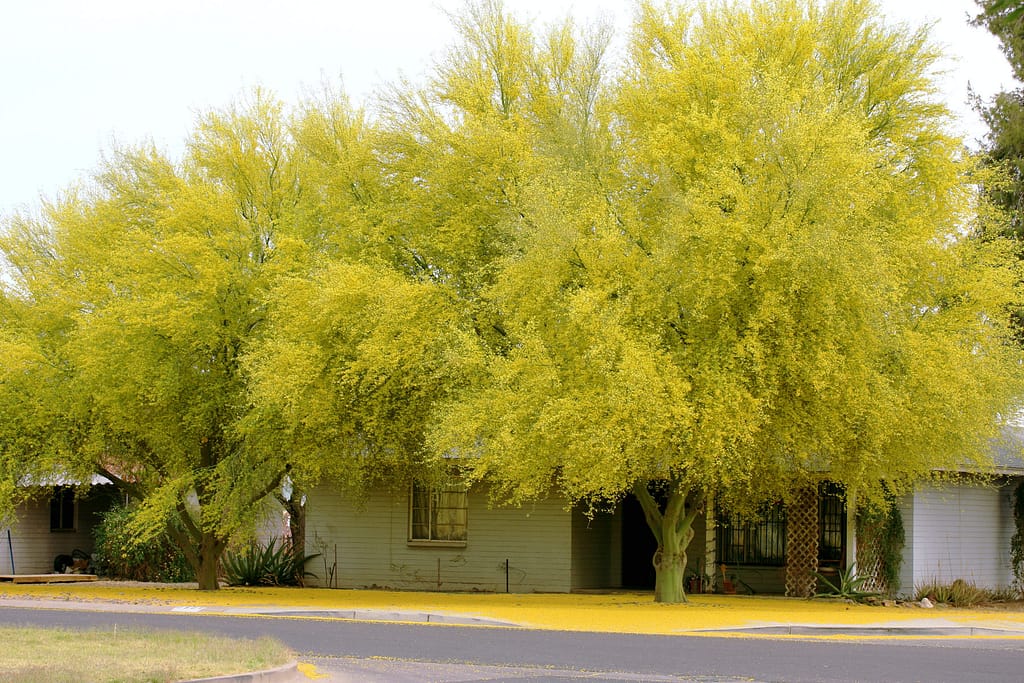
Why Plant A Palo Verde?
Palo verde trees are very well adapted to the Mojave desert. Not only are they native to the deserts of the south west, but they thrive in compacted soils that we have in our urban communities. They are extremely drought tolerant, flower profusely through the summer, and give year long interest with their green trunks that show forth after leaf fall. They also have a low maintenance cost for most of the life of the tree after establishment.
Varieties and Cultivars
Blue Palo Verde – Parkinsonia florida – upright growth habit, wide spreading crown, up to 30′ tall
Foothills Palo Verde (Little Leaf Palo Verde) – Parkinsonia microphylla – shrubbier, slower growing, and up to 20′ tall, has thorns
Sonoran Palo Verde (Palo Brea) – Parkinsonia praecox – smooth blue-green bark, fewer low branches, up to 35′ tall
Mexican Palo Verde – Parkinsonia aculeata – rapid growth rate, up to 30′ tall, thorns
Desert Museum Palo Verde – Parkinsonia x ‘Desert Museum’ – Hybrid of Blue, Foothills, and Mexican. Little no to seed pods, no thorns, fast growth rate (with longer lifespan)
Most nurseries will carry the either the Mexican or Desert Museum palo verdes. The others are more rare to come across in the general nursery industry and you might have to seek out a native plant nursery to find them. The Desert Museum palo verdes are much more expensive than the others due to it having all of the desirable characteristics and being more difficult to propagate. Cuttings have a low success rate unless you follow a very specific routine with them, and you cannot grow them from seed because they don’t come true through seed. Air-layering is a common method of propagation.
Complaints About The Palo Verde
- Seed pods are “messy” and some find them “unsightly” (Desert Museum Palo Verde trees have little to no seed pods)
- Several varieties have thorns
- They can die the first year or two after planting if subjected to a cold winter and/or are not protected
- Very small leaves can settle into the gravel or rock in your landscape
Misinformation About Palo Verdes?
One of the least understood things about palo verde trees is that they do not do well if the first year or two after being planted has a cold winter. I frequently come across customers that had theirs die over the winter, and this is due to several things:
- Cold tolerance goes up as branches and trunks get thicker
- Planting disturbs/interrupts the continuous sugar and starch production and this decreases cold tolerance
- An early cold snap or pruning too early in early fall / late summer also decreases cold hardiness
- Last the tree is not settled in to it’s permanent location. What this does to cold tolerance can be understood by imagining camping and sleeping with a blanket vs a sleeping bag. I don’t need to explain that much if you’ve been camping, but you’re ability to stay warm is severely limited with a blanket as opposed to a sleeping bag.
Growing from seed eliminates a few of the issues, but lack of trunk and branch girth still leaves you with a small susceptible tree.
So all that said, I typically recommend either planting a small tree (more difficult to come by), or to protect them the first winter or maybe even first two if possible. They become wonderful trees that are hardy, but they need time to establish before they are more carefree.
Right Tree, Right Place
To avoid problems of varying degrees, it is recommended these trees are NOT planted in the following places:
- Under power or utility lines
- Within 10′ of your home
- Within 20′ of your septic tank
Toxicity
Palo verde trees do not seem to be toxic to anything that I’ve found based on the following links and information:
- American Society for the Prevention of Cruelty to Animals – https://www.aspca.org/pet-care/animal-poison-control/toxic-and-non-toxic-plants
- Cornell Department of Animal Science – https://poisonousplants.ansci.cornell.edu/php/plants.php?action=display&ispecies=cattle
- USDA Agricultural Research Service – https://www.ars.usda.gov/ARSUserFiles/oc/np/PoisonousPlants/PoisonousPlants.pdf
